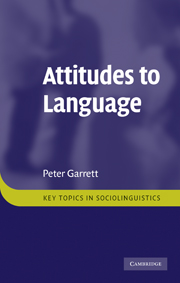Book contents
- Frontmatter
- Contents
- List of figures
- List of tables
- Acknowledgements
- 1 Introduction
- 2 Fundamentals of language attitudes
- 3 Main approaches to the study of language attitudes
- 4 Matched and verbal guise studies: focus on English
- 5 Matched and verbal guise research in more contexts
- 6 Attitudes to speech styles and other variables: communication features, speakers, hearers and contexts
- 7 Communication accommodation theory
- 8 Language attitudes in professional contexts
- 9 Societal treatment studies
- 10 Direct approach
- 11 Folklinguistics
- 12 An integrated programme of language attitudes research
- 13 Conclusion
- Glossary
- References
- Index
- References
4 - Matched and verbal guise studies: focus on English
Published online by Cambridge University Press: 05 June 2012
- Frontmatter
- Contents
- List of figures
- List of tables
- Acknowledgements
- 1 Introduction
- 2 Fundamentals of language attitudes
- 3 Main approaches to the study of language attitudes
- 4 Matched and verbal guise studies: focus on English
- 5 Matched and verbal guise research in more contexts
- 6 Attitudes to speech styles and other variables: communication features, speakers, hearers and contexts
- 7 Communication accommodation theory
- 8 Language attitudes in professional contexts
- 9 Societal treatment studies
- 10 Direct approach
- 11 Folklinguistics
- 12 An integrated programme of language attitudes research
- 13 Conclusion
- Glossary
- References
- Index
- References
Summary
The main focus in chapters 4 and 5 is on studies employing the matched guise (and verbal guise) approaches. In this chapter we shall start by revisiting the study by Giles (1970), briefly introduced in chapter 3, to draw out some of its features and findings regarding UK attitudes to different accents of English. We shall then discuss advantages and disadvantages of this approach to studying language attitudes. We shall then review a number of studies that have investigated attitudes to native varieties of English in other English-speaking countries. This gives the chapter something of a native speaker English tone, with attention largely focused on ‘inner circle’ Englishes (‘inner circle’ Englishes is a term from Kachru 1985, 1988 referring to the Englishes of Australia, Canada, New Zealand, the UK, the USA, and other countries where English is said to have a traditional basis). In chapter 5, though, we will extend to more contexts. Research methods issues will continue to be picked out in context as we go along.
UK: MORE DETAILS AND FINDINGS FROM GILES 1970
Giles' (1970) study presented accents of English to 177 secondary school students in South Wales and South-west England. The students were told they would be listening to different people, each reading in their own accent, although in reality the readings were all by the same person.
- Type
- Chapter
- Information
- Attitudes to Language , pp. 53 - 69Publisher: Cambridge University PressPrint publication year: 2010

